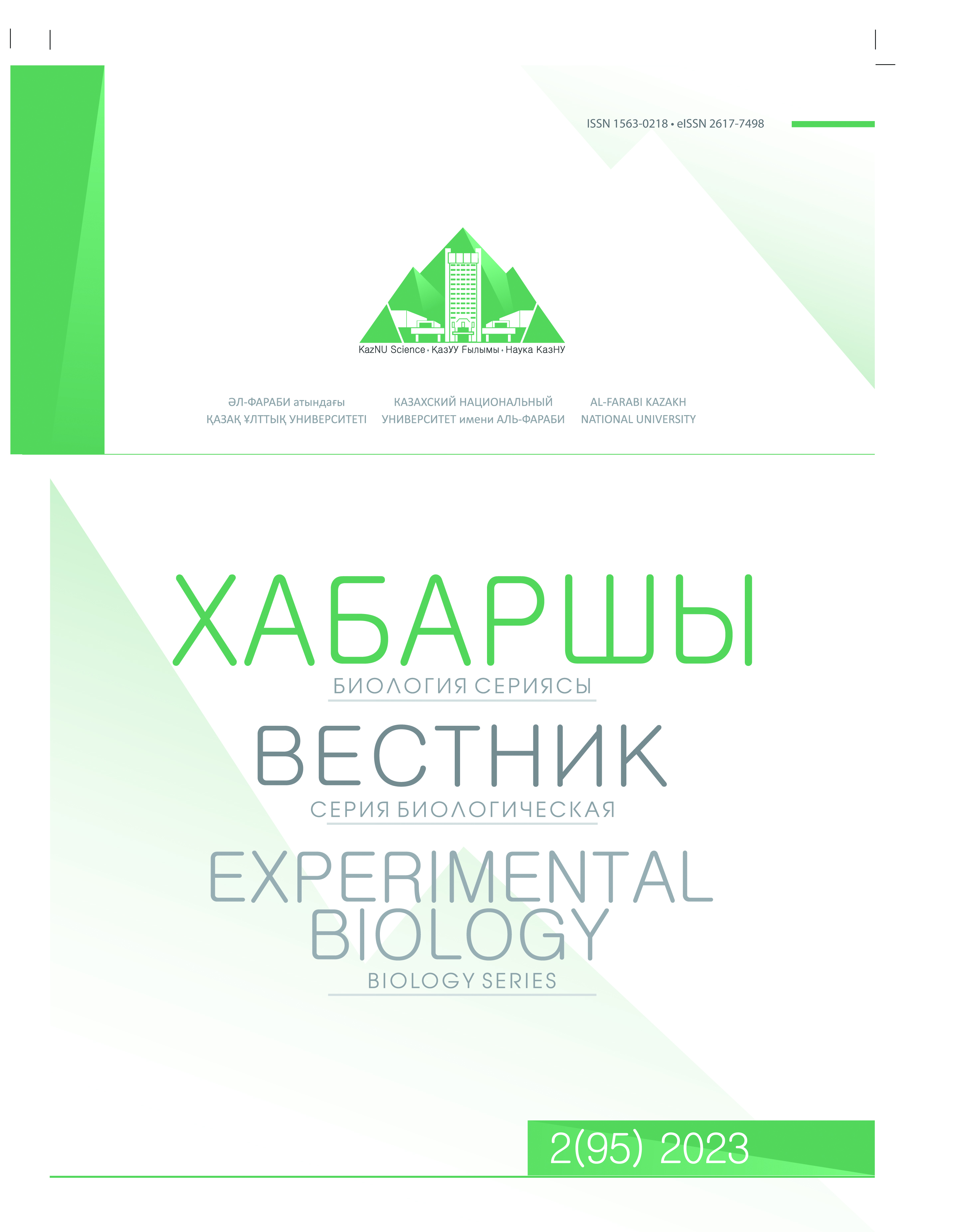STUDY OF THE EFFECT OF IMMOBILIZATION STRESS ON ERYTHROCYTE MEMBRANES
DOI:
https://doi.org/10.26577/eb.2023.v95.i2.015Keywords:
erythrocyte membrane, acute and chronic immobilization stress, hemolysis, vitamin E.Abstract
This article discusses the effect of acute and chronic immobilization stress on erythrocyte membranes. The intensive development of science and technology has brought into human life, along with positive phenomena, a number of unfavorable factors: hypodynamia, excessive nervous, physical exertion, professional and household stresses. Among them, hypodynamia is a lifestyle characterized by a decrease in motor activity, which negatively affects human health. This is a common situation nowadays. Hypodynamia leads to metabolic and energy disorders in the body, cardiovascular diseases, diseases of the gastrointestinal tract, overweight, early aging, a decrease in the body's ability to resist various diseases, changes in the general condition of the body, etc. Such a stressful effect is observed at the cellular and molecular level. As stress increases, metabolic disorders appear, activation of free radical oxidation leads to disruption of the main: barrier, receptor, catalytic functions of biological membranes. As a result, it leads the human body to various pathological conditions. Currently, more attention is being paid to an integrated approach to the treatment and prevention of diseases. This article discusses the effect of acute and chronic immobilization stress on erythrocyte membranes. As a result of the research, it was found that the effect of immobilization stress leads to a decrease in the osmotic and peroxide resistance of erythrocytes and an increase in the hemoglobin yield. The use of vitamin E reduces the damaging effect of both acute and chronic immobilization stress. Consequently, antioxidants can protect the body from the damaging effects of stress factors.
References
Alifirov A.I., Mikhaylova I.V. (2018) Physical Education Of Highly Qualified Chess Players. Research Journal of Pharmaceutical, Biological and Chemical Sciences, vol. 9, no 4, рр. 1725-1730.
Amlayev K. R., Koychuyeva S. M., Koychuyev A. A. (2012) Gipodinamiya: kak perelomit’ situatsiyu. Sovremennyye rekomendatsii po planirovaniyu fizicheskoy aktivnosti. Izvestiya Samarskogo nauchnogo tsentra RAN, vol 14, no 5 (2), pp. 518-521.
Artyukhov V.G., Nakvasina M.A. (2000) Biologicheskiye membrany: strukturnaya organizatsiya, funktsii, modifikatsiya fiziko-khimicheskimi agentami. Ucheb. Posobiye, Voronezh: Izd-vo VGU, pp. 296.
Alkadi H. (2020) A Review on Free Radicals and Antioxidants. Infect Disord Drug Targets, no 20(1), pp. 16-26.
Ayala A., Munoz M.F., Arguelles S. (2014) Lipid Peroxidation: Production, Metabolism, and Signaling Mechanisms of Malondialdehyde and 4-Hydroxy-2-Nonenal, Oxid Med Cell Longev, 2014:360438. doi: 10.1155/2014/360438.
Bikbulatova A.A., Andreeva E.G. (2018) Achievement of psychological comfort in 5-6-Year-Old children with scoliosis against the background of daily medicinal-prophylactic clothes’ wearing for half a year. Bali Medical Journal, vol. 7, no 3, pp. 706-711.
Dautova M.B., Dzhetpisbayeva G.D., Abisheva Z.S., Asan G.K., Zhurunova M.S., Raisov T.K., Iskakova U.B., Ismagulova
T.M. (2016) Vliyaniye gipodinamii na zhizn’ cheloveka. Mezhdunarodnyy zhurnal prikladnykh i fundamental’nykh issledovaniy, no 1 (4), pp. 542-543.
Dragoş D., Tanasescu M.D. (2010) The effect of stress on the defense systems. J Med Life, no 3(1), pp. 10-18.
Grishan M. A. (2018) Fiziologicheskiye posledstviya gipodinamii dlya organizma cheloveka. Zdorov’ye i obrazovaniye v XXI veke, vol 20, no 12, pp. 70-73.
Gutsol L.O., Guzovskaya Ye.V., Serebrennikova S.N., Seminskiy I.ZH. (2022) Stress (obshchiy adaptatsionnyy sindrom): lektsiya. Baykal’skiy meditsinskiy zhurnal, no 1(1), pp. 70-80.
Giovanni M., Ciro C., Michele M., Luca D., Pasquale N., Angela Gabriella D. (2022) Free Radical Properties, Source and Targets, Antioxidant Consumption and Health. Oxygen, no 2(2), pp. 48-78.
Halliwell B., Gutteridge J.M.C. (2015) Free Radicals in Biology and Medicine (5th edn). Oxford University Press, Online
ISBN: 9780191802133. https://doi.org/10.1093/acprof:oso/9780198717478.001.0001.
Il’yushin O.V., Bosyatov A.R. (2018) Gipokineziya i gipodinamiya, ikh neblagopriyatnoye vliyaniye na organism. Nauka i obrazovaniye: novoye vremya, no 6 (29), pp. 764-767.
Jos F. B., Bart V., Julian F Th. (2018) Generalized Unsafety Theory of Stress: Unsafe Environments and Conditions, and the Default Stress Response. Int. J. Environ ResPublic Health, vol.7, no.15(3), pp. 464.
Khnychenko L.K., Sapronov N.S. (2003) Stress i yego rol’ v razvitii patologicheskikh protsessov. Obzory po klinicheskoy farmakologii i lekarstvennoy terapii, vol 2, no 3, pp. 2-15.
Ludan V.V., Pol’skaya L.V. (2019) Rol’ antioksidantov v zhiznedeyatel’nosti organizma. Tavricheskiy mediko- biologicheskiy vestnik, vol 22, no 3, pp. 86-92.
Miroshina T.N., Murzakhmetova M.K., Utegaliyeva R.S. (2002) Korrigiruyushcheye deystviye indolaminov na sostoyaniye membrany eritrotsitov pri deystvii ionov kadmiya. Vestnik KazNU im. Al’-Farabi. Seriya biol, no 3, pp. 80-86.
Makhov A.S., Medvedev I.N. (2018) Physiological Danger Of Physical Inactivity For Humans.Research journal of pharmaceutical, biological and chemical sciences, vol. 9, no 6, pp. 375-380.
Novitskiy V.V., Gol’dberg Ye.D., Urazova O.I. (red.) (2015) Patofiziologiya. M.: GEOTAR-Media., ch 1.
Pham-Huy L.A., He H., Pham-Huy C. (2008) Free radicals, antioxidants in disease and health. Int. J. Biomed. Sci, no 4, pp 89–96.
Rubizova A.A., Zhdanova D.R., Dzheyranova M.O. (2017) Gipodinamiya – bolezn’ tsivilizatsii. Byulleten’ meditsinskikh Internet-konferentsiy, vol 7, no 6, pp. 1031-1032.
Sadovnichenko YU.A., Myasoyedov V.V. (2015) Kletochnyye membrany. Transportnoye vozdeystviye cherez plazmalemmu: Metod. rekom. dlya samost. vneaud. rabota stud. Khar’kov: KHNMU, pp. 15.
Stewart M.P., Langer R., Jensen K.F. (2018) Intracellular Delivery by Membrane Disruption: Mechanisms, Strategies, and Concepts. Chem Rev, no 118(16), pp. 7409–7531.
Uzbekov M.G. (2014) Perekisnoye okisleniye lipidov i antioksidantnyye sistemy pri psikhicheskikh zabolevaniyakh. Sotsial’naya i klinicheskaya psikhiatriya, vol 24, no 4, pp. 97–103.
Yunusova S.G., Rozental’ A.N., Baltina T.V. (2008) Stress. Biologicheskiye i psikhologicheskiye aspekty. Uchenyye zapiski Kazanskogo universiteta. Seriya Gumanitarnyye nauki, no 150(3), pp. 139-150.




